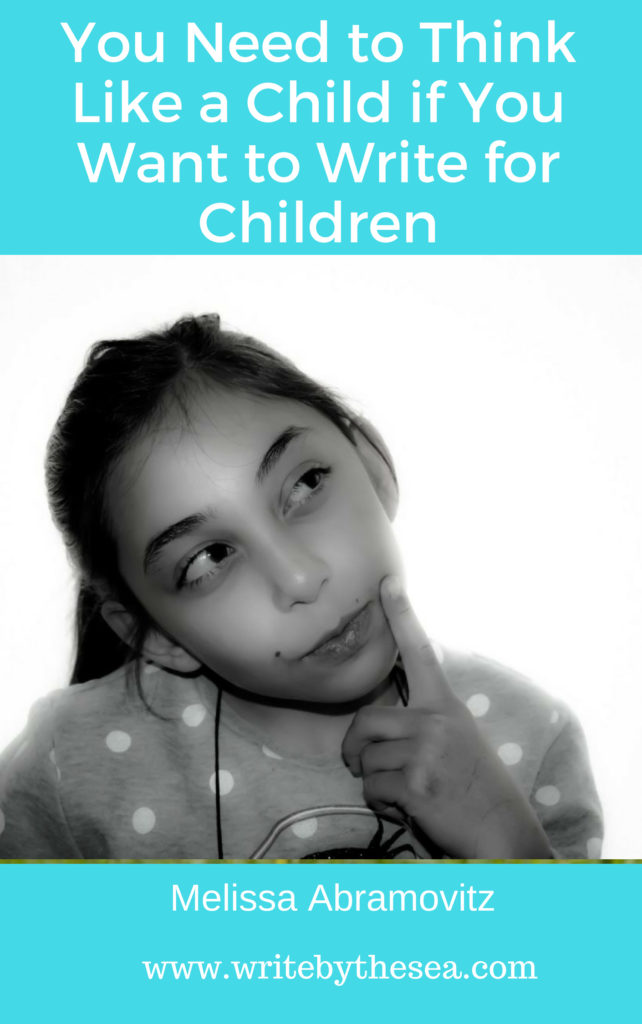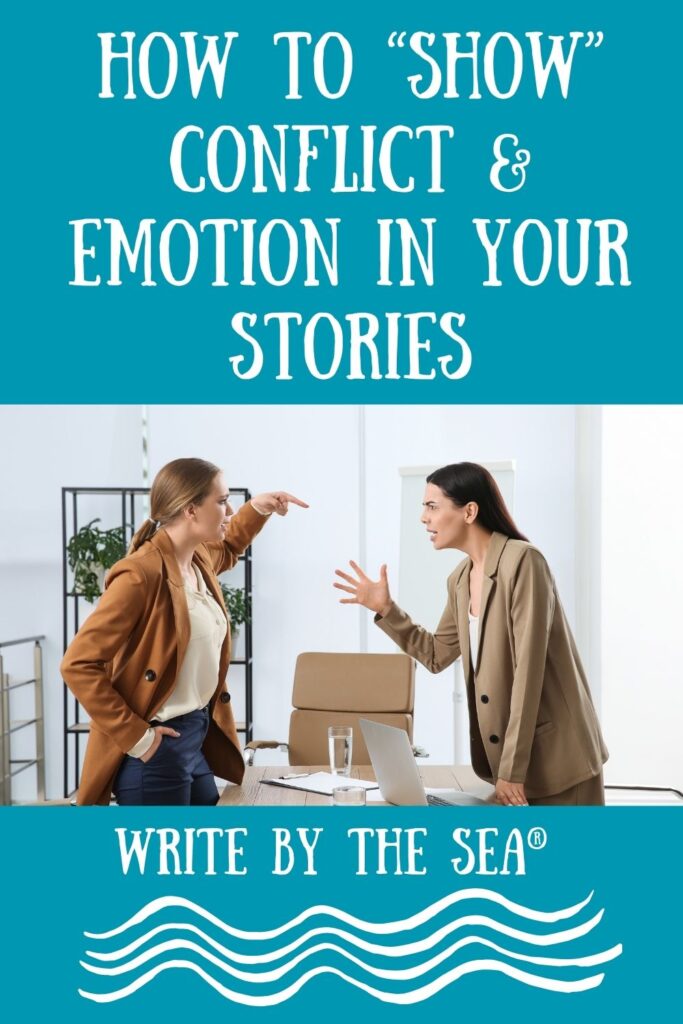A guest post from children’s author Melissa Abramovitz
Note: This post may contain some affiliate links for your convenience (which means if you make a purchase after clicking a link I will earn a small commission but it won’t cost you a penny more)! Read my full disclosure and privacy policies...
Authors who write for children must think like a child in several respects.
Whether you’re writing fiction or nonfiction, the subject matter, focus, point of view, and language should all reflect your ability to get inside a child’s head and express a story in a way that is interesting and appropriate for a kid of a particular age.
The best way to gain an understanding of what kids find interesting and what language is appropriate is to be around and observe children of different ages.
Parents, grandparents, teachers, and others who are often around children have a definite advantage, but even writers who are not routinely around kids can still observe them in public places and can benefit from published articles about their cognitive capabilities and interests.

Subject Matter
Children tend to be curious about most topics, as long as the material is presented in an interesting and age-appropriate way.
In general, subject matter that is inappropriate for young children (ages 2 to 8) and middle-grade children (ages 8 to 12) includes crime, violence, severe illness, and sex, unless the material is presented in a way that helps children stay safe or deal with real-life issues.
For instance, fiction or nonfiction books written to help young children who witness a terror attack or who experience having a parent die from a severe illness can be appropriate in certain cases.
Material that warns middle-grade children (ages 8 to 12) about issues like the dangers of drugs can also be appropriate.
But in general, kids will be most interested in stories and articles about school, family life, friendship, sports, science, nature, history, and technology.
For teens, controversial and unpleasant topics are acceptable, but writers still need to remember that teenagers are not adults.
Articles about science, technology, culture, history, health, social issues, and relationships can venture into controversial territory, but most teens are not interested in adult-like issues such as government budget woes, pension plans, or the latest household appliances.
Focus
Finding an appropriate topic that will appeal to children or teenagers is just the first step, since children’s stories and nonfiction articles must all be tightly focused.
In other words, choosing a broad topic like dogs or computers or holidays will not lend itself to the narrow, unique focus needed for books or magazine pieces for children of all ages.
Finding such a focused idea often results from simply being alert to one’s surroundings.
For instance, one day many years ago I was looking at my pocket calendar and noticed that there were no holidays listed during the month of August.
The calendar had at least one pre-printed holiday listed for every other month.
I wondered whether or not there actually were any holidays in August, and looked at a bunch of pocket, office, and wall calendars in several stores.
None listed any August holidays.
Then I consulted some books about holidays.
I found out that while it is true that there are no national holidays in the United States in August, other countries celebrate a variety of August holidays, and in the United States there are several unofficial commemorative or awareness “holidays” like Women’s Equality Day and National Family Day.
So I wrote a children’s article titled “Are There Any Holidays In August?” that discussed the reason for my investigation into August holidays and the origins and traditions associated with the August holidays throughout the world.
The article sold immediately because of its unique focus.
Another good way of deciding on a focus that will appeal to children is to listen to the questions children ask.
For example, a poem I wrote titled “Where Does The Sun Go At Night?” was directly inspired by my then-four-year-old son’s question.
Still another way of choosing a narrowly-focused topic is to envision zooming in on a subject by figuratively placing it under a microscope or zoom lens.
A general topic, such as dogs, would occupy a huge area – way too large to cover in a single article.
A subtopic – perhaps service dogs – would also not fit under the imagined microscope, but a narrowly focused topic like “Meet Joe’s Service Dog, Katy,” would definitely fit.
Point of View
Point of view refers to who is telling a story.
In children’s stories, it is important for the point of view to remain consistent, or readers will have trouble following the story.
The point of view is usually that of the main character (a child), and this character must therefore appear in each scene so the story continues to be told through his or her senses and mindset.
Authors must also be careful not to suddenly start discussing some aspect of the story from the perspective of an adult character who is helping the young protagonist.
This is indeed a common mistake that editors see frequently in children’s story submissions.
Although the point of view in children’s stories can be either first, second, or third person, most often, third person is used.
In first person, the main character personally tells the story, using “I” or “me” pronouns, as in “Today was the worst day of my life.”
When the main character speaks, quotation marks are therefore not used.
Young children, especially, may find the use of “I” confusing, so few books for very young children are told in first person.
The second person point of view, which uses the pronoun “you” to refer to and speak directly to the reader, is also rarely used in children’s stories because it can be confusing unless it is executed especially well.
An example would be starting a book with “What would you do if you saw a real, live monster on the way to school?”
Children enjoy stories that directly involve them, but many writers shy away from using second person because they find it difficult to consistently maintain.
The most commonly-used point of view in children’s stories is third person (limited), in which an unseen narrator uses pronouns such as “he,” or “she” to tell the story from the protagonist’s viewpoint.
For example, “Milo did not know where he was when he woke up” is told in third person limited viewpoint.
The unseen narrator knows what the protagonist is seeing, thinking, and feeling, and thus tells the story through this main character.
This point of view is easiest to consistently maintain and thus is usually easiest for young readers to comprehend.
Language
It’s useful to listen to how children of certain ages speak, as well as to read what’s published for different age groups, to gain an understanding of appropriate descriptive and conversational language for children’s stories.
As you study published articles and books, pay attention to word choices, sentence structure and length, how authors use examples and anecdotes, and how they go about explaining facts and ideas in simple, but not dumbed-down language.
This will give you a jumping-off point from which to develop your own style of putting words and sentences together.
There are a number of tools that can assist you in determining the age-appropriateness of language.
One good reference book is Children’s Writers Word Book, 2nd Edition, by Alijandra Mogilner and Tayopa Mogilner.
This book lists words according to when they are introduced in most schools.
It also contains a grade-level-appropriate thesaurus that is helpful for finding age-appropriate synonyms.
There are also a number of computer-based methods of checking reading or appropriate grade levels of certain words and sentences.
One is the Flesch-Kincaid Grade Level Score, which calculates a grade level score for a word, sentence, or passage based on the average number of syllables per word and the average number of words per sentence.
Flesch-Kincaid is programmed into some word processing programs, such as Microsoft Word.
However, in my experience, the word lists provided in Children’s Writers Word Book and the grade level calculations obtained through computer-based readability scores have limited value.
Some editors insist that writers use them, but many editors also realize that these tools often defy common sense.
For example, the Children’s Writers Word Book lists “hungry” as a second grade word, but I know from experience that much younger kids can read and understand this word.
So it’s best to use these tools only as guidelines and to apply common sense and experience when needed.
Also remember that challenging children with new vocabulary words is a good thing, as long as a clear definition and pronunciation guide are included and as long as really complex words are not thrown at very young children.
For example, I used the word “electroencephalograph” in an article on sleep for 8 to 12 year olds, but included a pronunciation guide and a breakdown and explanation of each part of the word.
In this case, watering down the article by stating “Doctors use a machine to measure brain waves during sleep” would have resulted in a vague explanation, so I chose to use the real name of the machine.
This would not have worked, however, for five or six year olds – this word is way too advanced, and younger kids would not even understand the concept that the brain emits invisible waves.
This aspect of sleep would not be appropriate to even mention in material for younger children.
In addition to paying attention to word usage, it’s also important that sentence structure for young readers is simple and short.
For instance, the ideal sentence length for kids ages 4 to 7 is four to ten words, and most material for kids aged 8 to 12 does not include sentences longer than about twenty words, with no more than two or three short phrases or clauses.
For example, the sentence “Sadie, who would celebrate her tenth birthday in less than one week, could not contain her excitement about the surprise party her friend Kari had accidently revealed to her when they were out shopping” is too complex for this age group.
And although teenagers are capable of reading sentences with fairly complex structure and vocabulary, it is still important to remember that material for teens should be less complex than that for adults.
Although getting “inside” children’s brains to write for them is challenging, I, and many other authors, find it exciting.
For one thing, I find that writing for a variety of age groups keeps things from ever getting boring for me.
But whether you choose to specialize in writing for one age group or for many, hopefully you will discover that your excursion inside these children’s minds will help you “rediscover” the magic of looking at the world through a child’s eyes.
About Melissa Abramovitz
 Melissa Abramovitz was an award-winning author/freelance writer who specialized in writing educational nonfiction books and magazine articles for all age groups, from preschoolers through adults.
Melissa Abramovitz was an award-winning author/freelance writer who specialized in writing educational nonfiction books and magazine articles for all age groups, from preschoolers through adults.
She also wrote short stories, poems, and picture books, and is the author of the book for writers, A Treasure Trove of Opportunity: How to Write and Sell Articles for Children’s Magazines.




